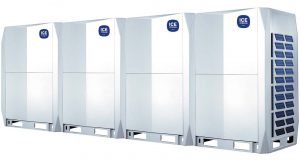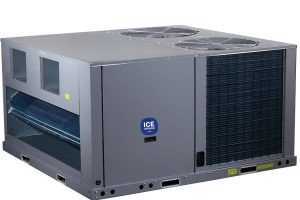VRV
- Ideal for offices, hotels, and residential buildings
- Available from 8 to 270 kW / 90,000 to 918,000 BTU
- R410 refrigerant
- Cooling only or reversible
- Many customized solutions
ROOF TOP
- Ideal for schools, warehouses, shops, and shopping centers
- Available from 60 to 300 kW / 200,000 to 1,000,000 BTU
- R410 refrigerant
- Cooling only or reversible
- Many customized solutions
Icestream, a recognized expert in air conditioning and heat pump systems, offers central air conditioning solutions. At Icestream, we understand that every space has specific needs for thermal comfort, which is why we provide systems that are both efficient and tailored to your requirements. Our solutions are designed to offer optimal comfort, high energy efficiency, and precise temperature control, meeting all your air conditioning expectations.
What is central air conditioning?
Central air conditioning is a type of cooling system that provides cool air to multiple rooms or an entire house or building from a central location. It is the most commonly used air conditioning system in large structures such as office buildings, large residential complexes, or spacious homes.
A central air conditioning system consists of one or more large condensers that are typically installed outside the building. These condensers cool the refrigerant, which is then circulated through ducts to indoor units distributed throughout the building. These units can be individually controlled to provide a suitable temperature for each zone or room.
The benefits of central air conditioning include superior cooling capacity, better energy efficiency when used to cool large spaces, and the ability to control the temperature in different parts of the building simultaneously. Additionally, since the condensing units are placed outside, central air conditioning systems are generally quieter inside the house or building.
However, installing central air conditioning may require significant modifications to the building structure and is usually more expensive than other air conditioning options. Therefore, careful planning and consulting with a professional are important before installing this type of system.
At Icestream, we have a range of central air conditioning systems suitable for different types of buildings and requirements. We are here to help you choose and install the system that best meets your needs.
In what context to use a central air conditioner?
The central air conditioning system is particularly suited for a variety of structures, especially large spaces. Here are some typical uses:
Hotels
Hotels can greatly benefit from this type of air conditioning since each room can have its own indoor unit. This allows for customized comfort for each guest.
Museums
Museums require specific environmental conditions for the preservation of their valuable pieces and artworks. Central air conditioning allows for rigorous control of temperature and humidity, ensuring high-quality preservation.
Hospitals
Air conditioning plays an important role in hospitals to ensure the comfort of patients, healthcare staff, and visitors. It is also useful for controlling air quality and maintaining sterile conditions in critical areas.
Educational Institutions
Schools, colleges, high schools, and universities benefit from central air conditioning to maintain optimal comfort in classrooms, libraries, and other shared spaces.
Offices and Business Premises
Offices and workspaces in the tertiary sector can benefit from this system to provide comfortable working conditions and promote productivity, with each area adjustable to a specific temperature.
Large Residences
Large residences such as mansions or large villas can benefit from this air conditioning system to maintain a level of comfort suitable for each space, ensuring an optimal standard of living.
What are the types of central air conditioning?
There are several types of central air conditioning systems suitable for various applications, whether in individual homes, apartment complexes, offices, or other large buildings. However, in France, the most commonly used system is the Variable Refrigerant Volume (VRV) system.
VRV Central Air Conditioning System
The VRV system, also known by the acronym DRV for Variable Refrigerant Volume, is a direct expansion air conditioning technology specifically designed for large private, semi-private, and commercial spaces such as offices or hotels.
Particularly innovative, this system consists of one or more outdoor units and can accommodate a large number of indoor units, up to 50 or more. It offers the possibility of reversible air conditioning, providing both cooling and heating, and incorporates energy recovery features.
The distinctive feature of this central air conditioning system is its variable refrigerant volume principle. The system precisely adjusts the amount of refrigerant sent to each indoor unit based on the specific needs of each area. It offers remarkable flexibility and precise temperature control in each space.
It is important to note that VRV air conditioning is primarily intended for professional applications, specially designed to meet the requirements of large spaces and provide optimal climate comfort in these specific environments.
In cooling mode, the VRV system operates on the principle of direct expansion. There is no need to transport water or air; it is the refrigerant fluid that plays the key role in this cooling process, which is repeated in each room where an indoor unit is installed.
In reversible mode, the VRV air conditioner can also provide heat. The heat exchanger then plays a dual role, acting as both an evaporator and a condenser. This function is made possible by the use of electronic expansion valves and a communication bus that allows coordination between all system components.
With its functionalities, the VRV air conditioning system offers great flexibility and precise temperature management in each zone or room, ensuring optimal thermal comfort in professional spaces.
Rooftop Air Conditioning System
There is also the rooftop air conditioning system. As the name suggests, these systems are typically installed on building rooftops. However, this type of central air conditioning is not used in Europe, as its application is primarily reserved for non-European areas.



